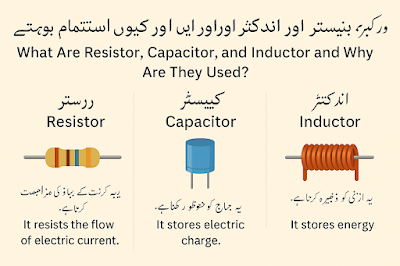What Are Resistor, Capacitor, and Inductor?
Resistor, Capacitor, and Inductor are the three fundamental components of electrical and electronic circuits. These components form the foundation of how most circuits operate, manage energy, and perform specific functions.
Resistor
Function:
A resistor opposes the flow of electric current, thereby controlling current and voltage within a circuit. It’s essential for protecting components and managing signal levels.
Construction:
Modern resistors are typically made from carbon, metal oxide, or other composite materials. They come in various shapes and sizes based on their resistance value and application.
Uses:
-
Switching circuits
-
Amplifier circuits
-
Control systems
-
Power supply units
Capacitor
Function:
A capacitor stores electrical energy temporarily in the form of an electric field. It works on the principle of static charge storage and can charge or discharge depending on the circuit.
Construction:
A capacitor is made by placing an insulating material (dielectric) between two metal plates. The dielectric could be paper, mica, glass, ceramic, or plastic.
Uses:
-
Filter circuits
-
Timing circuits
-
Power factor correction
-
Signal coupling and decoupling
Unique Property:
AC (alternating current) can pass through a capacitor, while DC (direct current) is blocked after the capacitor is charged.
Inductor
Function:
An inductor stores energy in a magnetic field when current flows through it. It works on the principle of electromagnetic induction, and resists sudden changes in current.
Construction:
An inductor is typically made by winding copper wire into a coil shape, sometimes around a core (air, iron, or ferrite).
Uses:
-
Switching power supplies
-
Radio frequency (RF) circuits
-
Microwave applications
-
Transformers and filters
Unique Property:
An inductor easily allows DC to pass, but it opposes AC, depending on the frequency.
Key Differences Between the Three
| Component | Function | Reacts to | Behavior |
|---|---|---|---|
| Resistor | Limits current | Current | Provides fixed resistance |
| Capacitor | Stores electric charge | Voltage | Blocks DC, passes AC |
| Inductor | Stores magnetic energy | Change in current | Blocks AC, passes DC |
Behavior in DC Circuits
-
Inductor: At the moment of switching ON, it behaves like an open circuit, and after some time, it acts like a short circuit.
-
Capacitor: Initially behaves like a short circuit when switching ON, but eventually acts like an open circuit once fully charged.
FAQs
Q1: What is a Resistor?
A: A resistor is an electronic component that restricts the flow of electric current. It’s measured in ohms (Ω) and helps control voltage levels in a circuit.
Q2: What is a Capacitor?
A: A capacitor is a two-terminal component that stores energy in an electric field. It can charge and discharge electrical energy and is measured in farads (F).
Q3: What is an Inductor?
A: An inductor is a coil that stores energy in a magnetic field when electric current flows through it. It is used to oppose sudden changes in current and is measured in henrys (H).
Q4: How do these components differ in function?
-
Resistor: Limits current flow
-
Capacitor: Stores and releases electric charge
-
Inductor: Stores magnetic energy and resists current changes
Q5: Where are these components commonly used?
They are found in:
-
Radios
-
Televisions
-
Power supplies
-
Filters
-
Communication systems
-
Computer circuits



